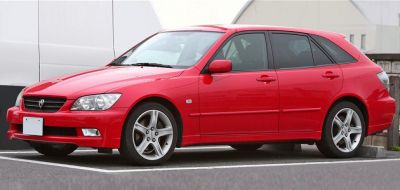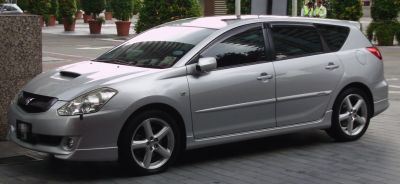 1999 Audi A4 Avant (B5, Typ 8D, facelift 1999) Dimensions, Size & Specs
1999 Audi A4 Avant (B5, Typ 8D, facelift 1999) Dimensions, Size & SpecsMeasurements of the 1999 Audi A4 Avant, engineered for optimal performance and comfort
| Dimensions | |
|---|---|
| Length: | 4479-4487 mm176.3-176.7 in14.7-14.7 ft |
| Width: | 1733 mm68.2 in5.7 ft |
| Width (Opened Mirrors): | 1848 mm72.8 in6.1 ft |
| Height: | 1417-1440 mm55.8-56.7 in4.6-4.7 ft |
| Trunk Capacity: | 390-878 liter13.8-31.0 cu ft |
| Trunk Capacity (Max): | 1250-1775 liter44.1-62.7 cu ft |
| Weight Specifications | |
| Curb Weight: | 1265-1520 kg2789-3351 lbs |
| Maximal permitted Weight: | 1815-2065 kg4001-4553 lbs |
| Roof Load: | 75 kg165 lbs |
| Tire Specifications | |
| Rims Sizes: | 15-inch rims:
|
| Tire Sizes: |
|
The Audi A4 Avant (B5, Typ 8D) facelift model produced between 1999 and 2001 is a versatile station wagon that combines compact dimensions with ample cargo space and practical design features. With an overall length ranging from 4479 mm to 4487 mm (176.3 to 176.6 inches), the B5 Avant is moderately sized, making it suitable for both urban use and longer journeys. It has a width of 1733 mm (68.2 inches), expanding to 1848 mm (72.8 inches) when including the opened side mirrors, and a height varying between 1417 mm and 1440 mm (55.8 to 56.7 inches), giving the vehicle a balanced and sleek profile.
Curb weight for this model varies from 1265 kg to 1520 kg (2789 to 3349 lbs), depending on the equipment and engine options. The maximum permissible weight ranges from 1815 kg to 2065 kg (4002 to 4554 lbs), highlighting its capacity to carry passengers and cargo efficiently. The luggage capacity is a standout feature, offering between 390 liters and 878 liters (13.8 to 31.0 cubic feet) with the rear seats in place, ideal for daily needs and family outings. Folding down the rear seats dramatically increases the cargo area to between 1250 liters and 1775 liters (44.1 to 62.7 cubic feet), making it suitable for larger items and road trips.
Practicality is further enhanced by a roof load limit of 75 kg (165 lbs), allowing for additional storage solutions such as roof boxes or bike racks. This generation of the Audi A4 Avant rides on 15-inch rims with a 6J width and typically uses tires sized 195/65 R15 or 205/60 R15. The combination of compact exterior dimensions, flexible cargo capacity, and moderate curb weight makes the Audi A4 Avant B5 facelift a well-rounded station wagon choice for drivers valuing style, space, and functionality.
Discover the standout features that make the 1999 Audi A4 Avant a leader in its class
Have a question? Please check our knowledgebase first.
The Audi A4 Avant B5 facelift model (produced from 1999 to 2001) comes with a length ranging between 4479 mm and 4487 mm (approximately 176.3 to 176.5 inches). The width measures 1733 mm (68.2 inches) excluding mirrors, and when the side mirrors are opened, the width extends to 1848 mm (72.8 inches). The height varies between 1417 mm and 1440 mm (55.8 to 56.7 inches), depending on specific trim and equipment. These compact yet practical dimensions allow the vehicle to comfortably fit into typical parking spaces while providing the spaciousness expected from a station wagon.
The curb weight of the Audi A4 Avant B5 facelift ranges from 1265 kg to 1520 kg (approximately 2789 to 3351 pounds), depending on engine choice, trim level, and optional equipment. Its maximum allowable weight spans between 1815 kg and 2065 kg (about 4005 to 4553 pounds). The variance in weight is typical for vehicles equipped with different engines and features, offering a balance between performance and practicality. This weight range supports agile handling while maintaining the sturdiness expected from a premium station wagon.
The Audi A4 Avant B5 facelift offers versatile cargo space suitable for family and cargo needs. With the rear seats in their upright position, the luggage capacity ranges from 390 liters to 878 liters (13.8 to 31 cubic feet), providing ample space for groceries, luggage, or sports equipment. When the rear seats are folded down, the cargo area expands significantly to between 1250 liters and 1775 liters (44.1 to 62.7 cubic feet), accommodating larger items such as furniture or bulky packages. This flexibility makes the Avant a practical choice for users requiring a combination of passenger comfort and cargo volume.
The roof load capacity for the Audi A4 Avant B5 facelift model is rated at 75 kilograms (approximately 165 pounds). This means that the car's roof can safely bear additional accessories such as roof racks, cargo boxes, or sports equipment, provided they do not surpass this weight threshold. Users looking to transport bikes, skis, or extra luggage on the roof can do so with confidence, but it is important to avoid exceeding this limit to ensure vehicle safety and maintain handling characteristics. Proper installation of roof racks and evenly distributed loads are strongly recommended.
This generation of the Audi A4 Avant typically comes equipped with 15-inch rims sized 6J x 15. Corresponding tire sizes generally include 195/65 R15 and 205/60 R15. These tire configurations balance ride comfort, grip, and fuel efficiency, contributing to the vehicle's well-rounded driving experience. Owners seeking to change or upgrade tires should maintain compatibility with these sizes to ensure optimal performance and safety.
Yes, the Audi A4 Avant B5 facelift fits comfortably into a standard residential garage. Standard garages typically measure around 2.4 to 2.7 meters (7.9 to 8.9 feet) in width, and since the Avant’s width is 1.733 meters (5.69 feet) without mirrors and 1.848 meters (6.06 feet) with mirrors extended, it provides sufficient clearance on either side. The height of approximately 1.44 meters (4.72 feet) is well under typical ceiling heights, ensuring ample vertical clearance. Its length of about 4.48 meters (14.7 feet) also fits within common garage dimensions. Overall, parking and maneuvering the vehicle indoors is convenient and hassle-free.
Compared to its predecessor, the original Audi A4 Avant B5 produced before the 1999 facelift, the facelifted model retains very similar overall dimensions, preserving its compact yet practical station wagon shape. Slight refinements in exterior styling and slight dimension tweaks may have occurred, but the length remains near 4.48 meters (14.7 feet), width around 1.73 meters (5.68 feet), and height just under 1.44 meters (4.7 feet), maintaining the versatile cargo and passenger space users appreciated. Weight and engine options might have varied somewhat, reflecting technological improvements and updated safety standards in the facelift period.
In the late 1990s and early 2000s, the Audi A4 Avant B5 facelift's dimensions and cargo capacity positioned it competitively among premium mid-size station wagons like the BMW 3 Series Touring and Mercedes-Benz C-Class Estate. Its length of roughly 4.48 meters (14.7 feet) and cargo space of up to 1775 liters (62.7 cubic feet) with seats folded offered a good balance of maneuverability and storage. While competitors might have slight differences in width or height, overall the A4 Avant provided comparable or slightly better cargo versatility paired with Audi's trademark solid build quality, making it a favored choice in its segment.
The interior of the Audi A4 Avant B5 facelift (1999-2001) offers comfortable and ergonomic seating for up to five passengers. With a focus on driver-centric design, controls are logically arranged, supporting ease of use and attention to the road. Headroom and legroom are generous for a mid-size estate, thanks in part to the vehicle’s height ranging from 1.417 to 1.44 meters (4.65 to 4.72 feet). Rear passengers benefit from spacious legroom and large windows enhancing visibility. Additionally, the ample cargo space with flexible seat folding options caters well to family or utility needs, reinforcing the vehicle’s reputation as a versatile and comfortable wagon.
The Audi A4 Avant B5 facelift offered a variety of engines, including both petrol and diesel variants, which influenced fuel efficiency and performance. Typically, petrol engines ranged from about 1.8 to 2.8 liters, with fuel consumption averaging between 7 to 10 liters per 100 kilometers (33 to 23.5 miles per gallon). Diesel variants generally provided better mileage, often achieving around 5 to 7 liters per 100 kilometers (47 to 33 mpg). Performance varied accordingly, with power outputs from approximately 125 to 190 horsepower depending on the engine chosen, delivering a balanced mix of spirited driving and economical commuting. This model was lauded for its smooth ride, responsive handling, and solid build quality.
Discover similar sized cars.

| Production: | 2001-2005 |
|---|---|
| Model Year: | 2002 |
| Length: | 4505 mm177.4 in |
| Width: | 1725 mm67.9 in |
| Height: | 1420-1435 mm55.9-56.5 in |

| Production: | 2002-2007 |
|---|---|
| Model Year: | 2002 |
| Length: | 4510 mm177.6 in |
| Width: | 1740 mm68.5 in |
| Height: | 1445 mm56.9 in |

| Production: | 2020-present |
|---|---|
| Model Year: | 2021 |
| Length: | 4571 mm180.0 in |
| Width: | 1792 mm70.6 in |
| Height: | 1514 mm59.6 in |

| Production: | 2016-2020 |
|---|---|
| Model Year: | 2016 |
| Length: | 4571 mm180.0 in |
| Width: | 1792 mm70.6 in |
| Height: | 1514 mm59.6 in |

| Production: | 2020-present |
|---|---|
| Model Year: | 2021 |
| Length: | 4571 mm180.0 in |
| Width: | 2002 mm78.8 in |
| Height: | 1514 mm59.6 in |

| Production: | 2016-2020 |
|---|---|
| Model Year: | 2016 |
| Length: | 4571 mm180.0 in |
| Width: | 2002 mm78.8 in |
| Height: | 1512 mm59.5 in |

| Production: | 2010-2014 |
|---|---|
| Model Year: | 2013 |
| Length: | 4556-4566 mm179.4-179.8 in |
| Width: | 1823 mm71.8 in |
| Height: | 1505 mm59.3 in |

| Production: | 2015-2018 |
|---|---|
| Model Year: | 2016 |
| Length: | 4559 mm179.5 in |
| Width: | 1793 mm70.6 in |
| Height: | 1487 mm58.5 in |
